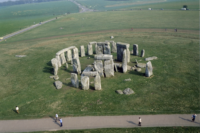Nobody knows for sure how or why Neolithic workers built the circle of giant rocks known as Stonehenge in southwest England. But they probably had less trouble winning support for their scheme than the government has now in diverting a busy highway away from the 4,500-year-old monument.
Dealing with congestion on the narrow road near the monument has defied planners for decades. The two-lane A303 highway, passing 165 meters south of the stones, is the main route through one of the country’s busiest tourist spots.
In a project valued at $2.2 billion, the government’s Highways England agency, which maintains and operates the country’s major highways, hopes to reroute and upgrade a 13-kilometer section of the route, adding 2.9 km of twin-bored tunnels 200 m south of the stones. As well as widening the road, the scheme would include a 210-m-long viaduct.
The construction would “trash” prehistoric artifacts around the 25-sq-km World Heritage Site, claims Kate Fielden, with the archaeological protection group Stonehenge Alliance. “The integrity of the whole site would be damaged.”
Stonehenge is set in a landscape rich in monuments from the early and late Neolithic periods and the early Bronze Age, according to English Heritage, the monument’s custodian.
Roughly 30.5 m in diameter, the stone circle was erected within an earthworks enclosure built some 500 years earlier. Of the 30 stones that formed the outer ring, 17 remain standing, linked by six lintels. Another eight uprights and two lintels lie flat on the ground.
These stones are 2.4-6.9 m tall and weigh about 25 tonnes each, English Heritage notes. Scholars believe they were transported from a site 30 km away.
Numerous 2.5-tonne bluestone monoliths are dotted within the outer ring. They were lugged 250 km from South Wales and floated over the Severn Estuary to the site, archaeologists believe.
To ease growing congestion on the A303, in the mid-1990s the government proposed widening the road to accommodate 40,000 vehicles a day. Withering criticism from English Heritage and others quickly torpedoed that plan.
Adopting a 2.1-km tunnel plan instead, the highway authority in 2004 hired a joint venture of two contractors to refine the scheme and set a cost target. Pending planning approval, the authority planned to award a design-build contract.
Upon approval in 2005, the government launched another review into the benefits of the project. That study in 2006 endorsed the proposal. But the next year, the government shelved the scheme on grounds of cost. After extensive public input on its latest proposal last year, Highways England on Feb. 8 published its plans, prompting mixed reactions.
Stonehenge Alliance rejects the proposal, saying the work would cause “major and irreversible harm” to the World Heritage Site as defined by the United Nations Educational, Science and Cultural Organization. UNESCO itself last year called for new ideas, such as a longer tunnel and new locations for its portals.
English Heritage and two other conservation organizations broadly support the new plan with improvements, including lengthening the tunnel to 3.2 km and adding substantial landscaping. Highways England has set an April 6 deadline for public comment, hoping to secure planning approval this year, says a spokesman. The Department for Transport prefers private funding, he adds. If all goes to plan, the new route will be in place in 2026.







Post a comment to this article
Report Abusive Comment